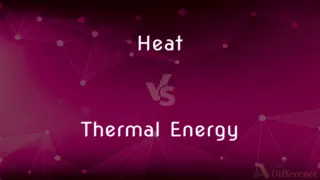Homologous vs. Heterologous — What's the Difference?
Edited by Tayyaba Rehman — By Urooj Arif — Updated on April 17, 2024
Homologous structures indicate evolutionary similarities, stemming from a common ancestor, whereas heterologous structures are diverse, arising from different evolutionary paths.

Difference Between Homologous and Heterologous
Table of Contents
ADVERTISEMENT
Key Differences
Homologous structures in biology refer to body parts or features in different species that are similar due to shared ancestry. These structures may serve different functions but have a similar underlying skeletal architecture. Whereas, heterologous structures, also known as analogous structures, are found in different species and perform similar functions but do not share a common ancestral origin. They are a result of convergent evolution, where different evolutionary pressures lead to similar solutions.
In the context of genetics, homologous chromosomes are pairs that contain the same genes at the same loci but possibly different alleles. They pair up during meiosis and are crucial for genetic diversity. On the other hand, heterologous chromosomes refer to non-pairing chromosomes that do not share homology or similar gene content, reflecting significant genetic differentiation.
Homologous recombination is a process in cellular biology where genetic material is exchanged between two similar or identical strands of DNA. It is important for DNA repair and for generating genetic diversity during meiosis. Conversely, heterologous expression involves introducing a gene from one organism into a different organism to produce a protein, often used in biotechnology for producing pharmaceuticals or studying gene functions.
In terms of immunology, homologous antigens are those that a species recognizes as its own, usually not triggering an immune response. In contrast, heterologous antigens are recognized as foreign by the immune system and can provoke an immune response, essential for the effectiveness of vaccines and understanding pathogen interactions.
Homologous series in chemistry refers to groups of organic compounds that share the same functional group and general formula, differing only by the number of CH2 units. This similarity offers predictability in chemical behavior. Heterologous, in this context, doesn't directly apply as it isn't commonly used in chemistry to describe series or relationships between compounds, emphasizing the term's specific biological connotations.
ADVERTISEMENT
Comparison Chart
Definition in Biology
Structures derived from a common ancestor
Structures with different ancestries
Example in Biology
Human arm and whale fin
Wings of birds and insects
Genetic Context
Homologous chromosomes in meiosis
Heterologous expression in gene studies
Role in Evolution
Evidence of common ancestry
Evidence of convergent evolution
Application in Biotechnology
Homologous recombination in gene therapy
Heterologous protein production in pharmaceutics
Compare with Definitions
Homologous
Involving similarity due to common ancestry.
Homologous genes in different species show similar sequences.
Heterologous
Refers to antigens that evoke an immune response due to non-self recognition.
Vaccines often use heterologous antigens to stimulate immunity.
Homologous
Pertaining to recombination events involving similar DNA sequences.
Homologous recombination is key to DNA repair mechanisms.
Heterologous
Related to the expression of a gene in a non-native host.
Heterologous protein production is common in pharmaceutical manufacturing.
Homologous
Related to the concept of homology in evolutionary biology.
Homologous structures can be identified by their anatomical similarities.
Heterologous
Involving organs or tissues not normally found together.
Heterologous heart transplantation involves a donor and recipient of different species.
Homologous
Pertaining to two or more structures derived from a common ancestor.
The human arm is homologous to the wing of a bat.
Heterologous
Used in describing unrelated elements within a particular context.
Heterologous elements were used to enhance the genetic construct.
Homologous
Related to chromosomes that pair during meiosis.
Homologous chromosomes undergo crossing over during meiosis.
Heterologous
Pertaining to structures or genes originating from different evolutionary lines.
The wings of a butterfly and a bird are heterologous.
Homologous
Corresponding or similar in position, value, structure, or function.
Heterologous
The term heterologous has several meanings in biology.
Homologous
Derived from the same species
A homologous graft.
Heterologous
Not corresponding or similar in position, value, structure, or function; not homologous.
Homologous
(Biology) Similar in structure and evolutionary origin, though not necessarily in function, as the flippers of a seal and the hands of a human.
Heterologous
(Biology) Relating to traits, such as organs or body parts, that do not correspond in structure or evolutionary origin.
Homologous
(Immunology) Relating to the correspondence between an antigen and the antibody produced in response to it.
Heterologous
Derived from a different species
A heterologous transplant.
A heterologous gene.
Homologous
Relating to chromosomes that have the same morphology and linear sequence of gene loci.
Heterologous
(Genetics) Relating to chromosomes that do not normally pair during mitosis or meiosis.
Homologous
Relating to genes that are derived from a common ancestor.
Heterologous
Relating to cells or tissues that do not usually occur in a given part of the body
A heterologous tumor.
Homologous
(Chemistry) Belonging to or being a series of organic compounds, each successive member of which differs from the preceding member by a constant increment, especially by an added CH2 group.
Heterologous
Relating to a vaccine or serum that confers immunity against a pathogen that is not identical to but is immunologically related to the pathogen used to create the vaccine or serum.
Homologous
Showing a degree of correspondence or similarity.
Heterologous
Relating to an antigen and antibody that do not correspond to one another.
Homologous
(mathematics) In corresponding proportion.
Heterologous
Having different relationships or different elements
Homologous
(biology) Corresponding to a similar structure in another life form with a common evolutionary origin.
Flippers and hands are homologous structures.
Heterologous
(biology) Of, or relating to different species
Homologous
(chemistry) Belonging to a series of aliphatic organic compounds that differ only by the addition of a CH₂ group.
Heterologous
Characterized by heterology; consisting of different elements, or of like elements in different proportions; different; - opposed to homologous; as, heterologous organs.
Homologous
(genetics) Having the same morphology as another chromosome or locus; relating to a homologue.
Heterologous
Having the same evolutionary origin but serving different functions;
The wing of a bat and the arm of a man are homologous
Homologous
Playing the same role as seen in another culture, whether by historical connection, psychological archetype, convergent cultural evolution, or otherwise (as may be hypothesized but not known with certainty by current science), as for example with the cryptozoologic concepts of yeti and sasquatch, the use of polite and familiar pronouns, or other similarities.
Heterologous
Derived from organisms of a different but related species;
A heterologous graft
A homologous tissue graft
Homologous
Having the same relative position, proportion, value, or structure.
In similar polygons, the corresponding sides, angles, diagonals, etc., are homologous.
Homologous
Having the same relative proportion or value, as the two antecedents or the two consequents of a proportion.
Homologous
Having the same evolutionary origin but serving different functions;
The wing of a bat and the arm of a man are homologous
Homologous
Corresponding or similar in position or structure or function or characteristics; especially derived from an organism of the same species;
A homologous tissue graft
A heterologous graft
Common Curiosities
How can identifying homologous structures help in studying evolution?
Studying homologous structures helps scientists understand the evolutionary relationships between different species, indicating how species have diverged from common ancestors.
What are some practical applications of heterologous protein production?
Heterologous protein production is used in manufacturing pharmaceuticals like insulin, vaccines, and enzymes, utilizing genetic engineering to produce proteins not typically available in host organisms.
What is the difference between homologous and heterologous structures?
Homologous structures have similar origins and skeletal layouts but may perform different functions, whereas heterologous structures perform similar functions but come from different evolutionary backgrounds.
What role do homologous chromosomes play in reproduction?
Homologous chromosomes pair up during meiosis to exchange genetic material, ensuring offspring receive a mix of genes from both parents, which is essential for genetic diversity.
How does homologous recombination differ from heterologous expression?
Homologous recombination is a natural process of genetic exchange between similar DNA molecules, primarily for repair and genetic diversity. Heterologous expression involves artificially inserting genes from one organism into another to produce specific proteins.
What is an example of homologous recombination in medical research?
Homologous recombination is used in gene therapy to correct defective genes responsible for diseases, ensuring precise DNA repair and replacement.
Are there ethical concerns associated with heterologous gene expression?
Yes, ethical concerns arise, particularly when it involves transgenic organisms, impacting ecosystems, and potential risks of gene transfer between species.
What are the limitations of using homologous recombination in genetic engineering?
Homologous recombination can be less efficient compared to other methods and requires highly similar DNA sequences to be effective, limiting its use in more complex genetic manipulations.
Why is heterologous expression important in research?
Heterologous expression allows scientists to study the function of genes and proteins in a controlled environment, aiding in drug development and genetic research.
Can heterologous tissues be used in medical treatments?
Yes, heterologous tissues, such as those from animals like pigs, can be modified and used in human treatments, such as heart valve replacements.
What are the challenges in identifying heterologous structures in paleontology?
Distinguishing heterologous from homologous structures in fossil records can be challenging due to convergent evolution, which may mask the true evolutionary relationships between species.
What evidence do homologous structures provide about common ancestors?
Homologous structures show that diverse species evolved from a common ancestor, sharing a basic structural framework that has been adapted over time.
How does convergent evolution relate to heterologous structures?
Convergent evolution leads to heterologous structures when unrelated species evolve similar traits independently to adapt to similar environmental challenges or niches.
How do homologous genes contribute to species diversity?
Homologous genes undergo mutations and recombination over generations, contributing to the genetic variability and adaptability of species.
How do homologous and heterologous structures impact the classification of organisms?
Understanding these structures helps in classifying organisms based on evolutionary relationships (homologous) or ecological roles and adaptations (heterologous), shaping taxonomic categorization.
Share Your Discovery

Previous Comparison
Dame vs. Baroness
Next Comparison
Coma vs. SyncopeAuthor Spotlight
Written by
Urooj ArifUrooj is a skilled content writer at Ask Difference, known for her exceptional ability to simplify complex topics into engaging and informative content. With a passion for research and a flair for clear, concise writing, she consistently delivers articles that resonate with our diverse audience.
Edited by
Tayyaba RehmanTayyaba Rehman is a distinguished writer, currently serving as a primary contributor to askdifference.com. As a researcher in semantics and etymology, Tayyaba's passion for the complexity of languages and their distinctions has found a perfect home on the platform. Tayyaba delves into the intricacies of language, distinguishing between commonly confused words and phrases, thereby providing clarity for readers worldwide.















































